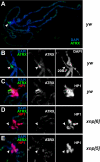Protein complex of Drosophila ATRX/XNP and HP1a is required for the formation of pericentric beta-heterochromatin in vivo
- PMID: 20154359
- PMCID: PMC2865330
- DOI: 10.1074/jbc.M109.064790
Protein complex of Drosophila ATRX/XNP and HP1a is required for the formation of pericentric beta-heterochromatin in vivo
Abstract
ATRX belongs to the family of SWI2/SNF2-like ATP-dependent nucleosome remodeling molecular motor proteins. Mutations of the human ATRX gene result in a severe genetic disorder termed X-linked alpha-thalassemia mental retardation (ATR-X) syndrome. Here we perform biochemical and genetic analyses of the Drosophila melanogaster ortholog of ATRX. The loss of function allele of the Drosophila ATRX/XNP gene is semilethal. Drosophila ATRX is expressed throughout development in two isoforms, p185 and p125. ATRX185 and ATRX125 form distinct multisubunit complexes in fly embryo. The ATRX185 complex comprises p185 and heterochromatin protein HP1a. Consistently, ATRX185 but not ATRX125 is highly concentrated in pericentric beta-heterochromatin of the X chromosome in larval cells. HP1a strongly stimulates biochemical activities of ATRX185 in vitro. Conversely, ATRX185 is required for HP1a deposition in pericentric beta-heterochromatin of the X chromosome. The loss of function allele of the ATRX/XNP gene and mutant allele that does not express p185 are strong suppressors of position effect variegation. These results provide evidence for essential biological functions of Drosophila ATRX in vivo and establish ATRX as a major determinant of pericentric beta-heterochromatin identity.
Figures




Similar articles
-
Insights into HP1a-Chromatin Interactions.Cells. 2020 Aug 9;9(8):1866. doi: 10.3390/cells9081866. Cells. 2020. PMID: 32784937 Free PMC article. Review.
-
The XNP remodeler targets dynamic chromatin in Drosophila.Proc Natl Acad Sci U S A. 2009 Aug 25;106(34):14472-7. doi: 10.1073/pnas.0905816106. Epub 2009 Aug 11. Proc Natl Acad Sci U S A. 2009. PMID: 19706533 Free PMC article.
-
Characterization of the Drosophila group ortholog to the amino-terminus of the alpha-thalassemia and mental retardation X-Linked (ATRX) vertebrate protein.PLoS One. 2014 Dec 1;9(12):e113182. doi: 10.1371/journal.pone.0113182. eCollection 2014. PLoS One. 2014. PMID: 25437195 Free PMC article.
-
The Drosophila DAXX-Like Protein (DLP) Cooperates with ASF1 for H3.3 Deposition and Heterochromatin Formation.Mol Cell Biol. 2017 May 31;37(12):e00597-16. doi: 10.1128/MCB.00597-16. Print 2017 Jun 15. Mol Cell Biol. 2017. PMID: 28320872 Free PMC article.
-
Chromatin structure and ATRX function in mouse oocytes.Results Probl Cell Differ. 2012;55:45-68. doi: 10.1007/978-3-642-30406-4_3. Results Probl Cell Differ. 2012. PMID: 22918800 Review.
Cited by
-
Drosophila SUMM4 complex couples insulator function and DNA replication control.Elife. 2022 Dec 2;11:e81828. doi: 10.7554/eLife.81828. Elife. 2022. PMID: 36458689 Free PMC article.
-
ATRX proximal protein associations boast roles beyond histone deposition.PLoS Genet. 2021 Nov 15;17(11):e1009909. doi: 10.1371/journal.pgen.1009909. eCollection 2021 Nov. PLoS Genet. 2021. PMID: 34780483 Free PMC article.
-
Independent Biological and Biochemical Functions for Individual Structural Domains of Drosophila Linker Histone H1.J Biol Chem. 2016 Jul 15;291(29):15143-55. doi: 10.1074/jbc.M116.730705. Epub 2016 May 18. J Biol Chem. 2016. PMID: 27226620 Free PMC article.
-
Insights into HP1a-Chromatin Interactions.Cells. 2020 Aug 9;9(8):1866. doi: 10.3390/cells9081866. Cells. 2020. PMID: 32784937 Free PMC article. Review.
-
New chaps in the histone chaperone arena.Genes Dev. 2010 Jul 1;24(13):1334-8. doi: 10.1101/gad.1946810. Genes Dev. 2010. PMID: 20595228 Free PMC article.
References
-
- Wolffe A. P. (1995) Curr. Biol. 5, 452–454 - PubMed
-
- Luger K., Mäder A. W., Richmond R. K., Sargent D. F., Richmond T. J. (1997) Nature 389, 251–260 - PubMed
-
- Eissenberg J. C., Reuter G. (2009) Int. Rev. Cell Mol. Biol. 273, 1–47 - PubMed
-
- de Wit E., van Steensel B. (2009) Chromosoma 118, 25–36 - PubMed
-
- Fanti L., Pimpinelli S. (2008) Curr. Opin. Genet. Dev. 18, 169–174 - PubMed
Publication types
MeSH terms
Substances
Grants and funding
LinkOut - more resources
Full Text Sources
Molecular Biology Databases
Miscellaneous

